
Single coil
Encyclopedia
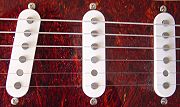
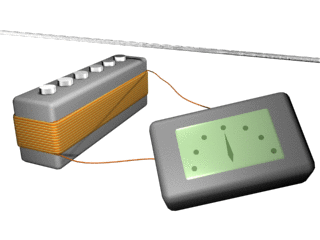
Transducer
A transducer is a device that converts one type of energy to another. Energy types include electrical, mechanical, electromagnetic , chemical, acoustic or thermal energy. While the term transducer commonly implies the use of a sensor/detector, any device which converts energy can be considered a...
, or pickup, for the electric guitar
Electric guitar
An electric guitar is a guitar that uses the principle of direct electromagnetic induction to convert vibrations of its metal strings into electric audio signals. The signal generated by an electric guitar is too weak to drive a loudspeaker, so it is amplified before sending it to a loudspeaker...
and the electric bass
Bass guitar
The bass guitar is a stringed instrument played primarily with the fingers or thumb , or by using a pick....
. It electromagnetically converts the vibration of the strings to an electric signal. Single coil pickups are one of the two most popular designs, along with dual-coil or "humbucking
Humbucker
A humbucker is a type of electric guitar pickup, first patented by Seth Lover and the Gibson company, that uses two coils, both generating string signal. Humbuckers have higher output than a single coil pickup since both coils are connected in series...
" pickups.
Beauchamp
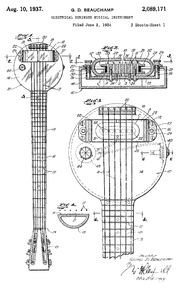
George Beauchamp
George Delmetia Beauchamp was an inventor of musical instruments and a co-founder of National Stringed Instrument Corporation and Rickenbacker guitars....
, a Los Angeles, California guitarist, began experimentation with electric amplification of the guitar. Originally using a phonograph pickup assembly, Beauchamp began testing many different combinations of coils and magnets hoping to create the first electromagnetic guitar pickup. He wound his earliest coils using a motor out of a washing machine, later on switching to a sewing machine motor, and eventually using single coiled magnets.
Beauchamp was backed in his efforts by Adolph Rickenbacker, an engineer and wealthy owner of a successful tool and die business. Beauchamp eventually produced the first successful single coil pickup. The pickup consisted of two massive "U" shaped magnets and one coil and was known as the "horseshoe pickup". The two horseshoe-shaped magnets surrounded the strings that passed over a single core plate (or blade) in the center of the coil.
Beauchamp outfitted the pickup in a custom built lap slide guitar. The production model based on this prototype became the Hawaiian Electro lap steel guitar
Lap steel guitar
The lap steel guitar is a type of steel guitar, an instrument derived from and similar to the guitar. The player changes pitch by pressing a metal or glass bar against the strings instead of by pressing strings against the fingerboard....
, nicknamed the "Frying Pan" for its round, flat body.
In 1931 Beauchamp founded the Ro-Pat-In Company with Rickenbacker and his associates. Ro-Pat-In eventually became The Electro String Instrument Corporation and subsequently the Rickenbacker
Rickenbacker
Rickenbacker International Corporation, also known as Rickenbacker, is an electric and bass guitar manufacturer based in Santa Ana, California...
International Corporation. The company introduced its first "Electro-String Instruments" to the public in 1932.
Gibson
The Gibson Guitar CorporationGibson Guitar Corporation
The Gibson Guitar Corporation, formerly of Kalamazoo, Michigan and currently of Nashville, Tennessee, manufactures guitars and other instruments which sell under a variety of brand names...
introduced the "bar pickup" in 1935 for its new line of Hawaiian lap steel guitars. The pickup's basic construction is that of a metal blade inserted through the coil as a shared pole piece for all the strings. A pair of large flat magnets were fastened below the coil assembly.
In 1936 Gibson introduced the ES-150, its first electric Spanish styled guitar. The ES-150 was outfitted with the bar pickup. Jazz guitar innovator, Charlie Christian
Charlie Christian
Charles Henry "Charlie" Christian was an American swing and jazz guitarist.Christian was an important early performer on the electric guitar, and is cited as a key figure in the development of bebop and cool jazz. He gained national exposure as a member of the Benny Goodman Sextet and Orchestra...
, began playing an ES-150 in the late 1930s with the Benny Goodman
Benny Goodman
Benjamin David “Benny” Goodman was an American jazz and swing musician, clarinetist and bandleader; widely known as the "King of Swing".In the mid-1930s, Benny Goodman led one of the most popular musical groups in America...
Orchestra. This caused the popularity of the electrified guitar to soar. Due to Christian’s close association with the ES-150 it began being referred to as the “Charlie Christian Model” and Gibson’s now famous bar pickup as the “Charlie Christian pickup” or “CC unit”.
Sound
The sound of a single coil pickup can range from the strong, fat midrange sound of the Gibson P-90 to the bright and clear Fender Telecaster single-coil tone.Gibson P-90
The P-90 is a single-coil pickup designed by the Gibson Guitar CorporationGibson Guitar Corporation
The Gibson Guitar Corporation, formerly of Kalamazoo, Michigan and currently of Nashville, Tennessee, manufactures guitars and other instruments which sell under a variety of brand names...
. These pickups have a large, flat coil with adjustable steel screws as pole pieces, and a pair of flat alnico bar magnets lying under the coil bobbin. The adjustable pole pieces pick up the magnetism from the magnets. Moving the screw closer or further away from the magnet determines signal strength, thus tone as well. There are two variations of P-90 pickup that differ mainly by mounting options:
- Soap bar casing has true rectangular shape and the mounting screws are contained within the coil perimeter, positioned between the pole pieces, between strings 2-3 and 4-5, thus creating irregular and somewhat unusual pattern. Occasionally, they are mistaken for pole pieces; thus, the P-90 is sometimes erroneously said to have eight pole pieces. The "soap bar" nickname most probably comes from its predominantly rectangular shape and proportions resembling a bar of soap, and the fact that the first P-90s on the original Gibson Les PaulGibson Les PaulThe Gibson Les Paul was the result of a design collaboration between Gibson Guitar Corporation and the late jazz guitarist and electronics inventor Les Paul. In 1950, with the introduction of the Fender Telecaster to the musical market, electric guitars became a public craze. In reaction, Gibson...
Model of 1952 were white.
- Dog ear is a casing type with extensions at both sides of pickup that somewhat resemble dog's ears. These are extensions of the predominantly rectangular cover that encompass the outlying mounting screws. Dog-ear P-90 pickups were commonly mounted on Gibson's hollowbody guitars like the ES-330Gibson ES-330The Gibson ES-330 is a thinline hollowbody electric guitar model produced by the Gibson Guitar Corporation.Though similar in appearance to the popular Gibson ES-335 semi-hollow guitar, the ES-330 was a fairly different guitar in construction and sound...
and occasionally on solid body models like the Les Paul JuniorGibson Les Paul JuniorThe Gibson Les Paul Jr. is a solid body electric guitar introduced in 1954 as an affordable, entry level Les Paul. It was first released with a single cut body style however models with a double cut body style were later introduced in 1958.-History:...
. The same pickups were also available on Epiphone models (since Gibson was building Epiphone guitars in the 1950s) and the design is best remembered for its appearance on the hollow body Epiphone CasinoEpiphone CasinoThe Epiphone Casino is a thinline hollow body electric guitar manufactured by Epiphone, a branch of Gibson. It is essentially Epiphone's version of the Gibson ES-330...
of the mid to late 1960s.
The sound of a P-90 is somewhat brighter and more transparent than Gibson's later humbucker
Humbucker
A humbucker is a type of electric guitar pickup, first patented by Seth Lover and the Gibson company, that uses two coils, both generating string signal. Humbuckers have higher output than a single coil pickup since both coils are connected in series...
pickup, and every bit as crisp and snappy as Fender's single-coil pickups despite its high output and big sound.
Despite its tonal qualities the P-90 fell out of favor with Gibson in the early 1950s as a consequence of guitar players complaining about the amount of hum (noise) it put out. Gibson employee Seth Lover
Seth Lover
Seth Lover is most famous for inventing the humbucker or hum-cancelling electric stringed instrument pickup, most often used on the electric guitar....
solved the hum problem by designing a hum-canceling pickup known as a humbucker, it was supposed to sound like a P-90 but in fact has quite a different sound. It nevertheless became Gibson's mainstay pickup from that point on. The P-90 likely did not become as popular for that reason, although many guitarists still prefer the tone of the P-90.
The hum problem proved extremely difficult to solve and despite numerous attempts by Gibson with their P-100, and the larger aftermarket pickup manufacturers with their stacked and sidewinders noiseless designs, hum-canceling P-90 pickups lost most of their favored tonal characteristics and generally did not gain acceptance among guitar players.
Telecaster design

Fender Telecaster
The Fender Telecaster, colloquially known as the Tele , is typically a dual-pickup, solid-body electric guitar made by Fender.Its simple yet effective design and revolutionary sound broke ground and set trends in electric guitar manufacturing and popular music...
features two single coils. The neck pickup produces a mellower sound, while the bridge pickup produces an extremely twangy, sharp tone with exaggerated treble response, because the bridge pickup is mounted on a steel plate. These design elements allow musicians to emulate steel guitar
Steel guitar
Steel guitar is a type of guitar or the method of playing the instrument. Developed in Hawaii in the late 19th and early 20th centuries, a steel guitar is usually positioned horizontally; strings are plucked with one hand, while the other hand changes the pitch of one or more strings with the use...
sounds, making it particularly appropriate for country music.
Pickups are selected with a three-position switch, and two wiring schemes exist:
- Vintage: 1) neck pickup with treble cutoff for a bassier sound; 2) neck pickup only; 3) bridge pickup only.
- Modern: 1) neck pickup only, with no treble cutoff; 2) neck and bridge; 3) bridge pickup only.
The Fender Esquire has a variation to the Vintage wiring scheme by using the scheme on a single pickup. This gives a treble cutoff in the first position, normal in the middle position, and a tone control cutoff in the third position.
Stratocaster design
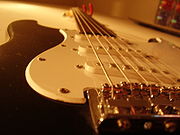
Switch
In electronics, a switch is an electrical component that can break an electrical circuit, interrupting the current or diverting it from one conductor to another....
. The pickup positions are usually referred to as the bridge
Bridge (instrument)
A bridge is a device for supporting the strings on a stringed instrument and transmitting the vibration of those strings to some other structural component of the instrument in order to transfer the sound to the surrounding air.- Explanation :...
, middle and neck
Neck (music)
The neck is the part of certain string instruments that projects from the main body and is the base of the fingerboard, where the fingers are placed to stop the strings at different pitches. Guitars, lutes, the violin family, and the mandolin family are examples of instruments which have necks.The...
pickups based on their proximity to those parts of the instrument.
Pickup position, number of coil winds, type of magnet wire, magnets and other factors shape the sound. A given pickup in the neck position will give louder, mellower and warmer sound, while an identical pickup in the bridge position will have lower output and produce a brighter, sharper sound. The reason the neck pickup has the most output is that the string's vibration has a higher amplitude
Amplitude
Amplitude is the magnitude of change in the oscillating variable with each oscillation within an oscillating system. For example, sound waves in air are oscillations in atmospheric pressure and their amplitudes are proportional to the change in pressure during one oscillation...
at the neck position, being near the middle of the string length. Some manufacturers overwind the bridge pickup for more output to compensate for this difference.
The magnet poles have different heights. This is called a magnet stagger and is done to compensate for the different outputs of the string for two reasons. The first reason is that the fretboard has a radius (also called camber) of between 7 and 12 inches usually. Naturally the strings will follow the radius of the fretboard and so must the top surface of the magnets, generally speaking. The second reason is that some strings have naturally higher output, the plain or non-wound G-string being the most significant and this calls for the corresponding magnet to be further compensated, resulting in an apparent odd looking stagger. Fender Strat pickups generally follow the traditional design and have the G string's magnet pole piece as tall as the D-string's, but this causes the G-string of modern string sets to be excessively loud and dominate all the other strings. This comes about because Stratocaster pickups were designed in the 1950s when string sets came with a wound G-string, but modern rock and blues players found it difficult to stretch or bend wound G-strings across the fretboard because of their inherently higher tension. In the 1970s, string manufacturers responded and introduced the now standard non-wound G-string which has lower tension and can be stretched more easily, but which produces much higher output. In order for the G-string to have the same output the corresponding magnet pole should have the greatest gap between the string and the magnet pole piece, thus different strings have magnets with differently compensated heights.
The first Stratocasters had a three-way pickup selector switch, selecting either the neck, middle or bridge pickup. Innovative guitarists found they could get an interesting sound by carefully positioning the selector switch lever between detented positions, where any two adjacent pickups would be on simultaneously. Some players wedged a plectrum between the pickguard and the selector switch to lock it in these positions. Later on, Fender introduced the now standard five-way selector switch, which uses additional detents between the original three positions to allow the combinations of any two adjacent pickups.
Modern Stratocasters have five-position pickup selector switch. Positions 1, 3 and 5 activate only one pickup (bridge, middle or neck respectively), while positions 2 and 4 activate a combination of two pickups (bridge and middle, or middle and neck, respectively). Some pickup sets have a reverse wound and reverse polarity middle pickup that when in combination with the normal bridge or neck pickups will cancel electromagnetic interference (noise/hum) which single coil pickups suffer badly from. The sonic effect of positions 2 and 4 is sometimes referred to as a "quack" or "notch positions", and some guitar notation includes directions to use these pickup combinations. One example is "Sultans of Swing
Sultans of Swing
"Sultans of Swing" was the first single release of the British rock band Dire Straits. First released in 1978, its 1979 re-release caused it to become a hit in both the UK and USA....
" by Dire Straits
Dire Straits
Dire Straits were a British rock band active from 1977 to 1995, composed of Mark Knopfler , his younger brother David Knopfler , John Illsley , and Pick Withers .Dire Straits' sound drew from a variety of musical influences, including jazz, folk, blues, and came closest...
which is played in position 2 (bridge and middle).
Noise problems
It is important to understand that there are two types of noise that afflict magnetic guitar pickups, hum and buzz. Hum is directly attributed to magnetic disturbances in the ether caused by 50Hz or 60Hz alternating mains from electrical equipment, whereas buzz is propagated as Radio transmissions and sounds more like static. Simply put, the sources of buzz are many but one example is an AC power tool with a brush motor. The Brush (electric)Brush (electric)
A brush is a device which conducts current between stationary wires and moving parts, most commonly in a rotating shaft. Typical applications include electric motors, alternators and electric generators.-Etymology:...
makes and breaks electrical contact with the commutator segment several thousand times a second at variable frequency dependent on load thus causing Radio noise propagation.
Hum can be canceled by suitable arrangements of two coils within the pickup's architecture. Hum can not be screened out by conductive shielding. Buzz can not be canceled, it can only be dealt with by conductive shielding installed in the wiring cavities of guitars and must be grounded.
Fender Stratocaster and Telecaster pickups as well as Gibson's P-90 pickup being of the single-coil type, output a type of noise known as mains hum or 50Hz / 60Hz hum. Mains hum has its origin in wiring of a building and electrical apparatus/appliances such as transformers, electric motors and lighting. Hum is undesirable because it pollutes the musical notes being played on the instrument with its own sound of fixed unchanging frequency or pitch (usually 50 or 60 hertz) which is discordant with the musical sounds. To address this undesirable situation various attempts to eliminate mains hum signal from Fender single-coil pickups were made dating back to the early 1970s. DiMarzio, Seymour Duncan and EMG manufacture what are commonly known as stacks, or stacked single coils which cancel mains hum. Unfortunately the design is flawed and these stacks also cancel string signal due to magnetic coupling of the two coils which has a detrimental effect on sound quality. EMG used active circuitry within the pickup to compensate for the losses caused by stacked coils by boosting and reshaping the damaged sound but this required an on-board battery with its attendant inconvenience. The resultant sound is not authentic Fender trade mark sound but EMG pickups became popular for their own sound.
Actodyne General manufactured a low-noise design of single-coil pickup known as Lace Sensors, Don Lace being the inventor. The Lace Sensor pickup had a rubberized particle magnet and used ferrous shielding to reduce hum. Being the best at the time, Fender installed Lace Sensors on the Strat Plus model for many years as a solution to the mains hum problem. However the Lace Sensor was a stopgap solution because the sound was not authentic Fender trademark sound. Fender purists wanted the genuine sound of the original Fender pickups with Alnico rod magnets and Fender eventually discontinued Lace Sensors as their mainstay solution to mains hum circa 1998. Lace Sensors continue to be used by many guitar players regardless.
Kinman Guitar Electrix
Kinman Guitar Electrix
Kinman Guitar Electrix is a small boutique Australian company that specializes in the design and manufacture of innovative Zero-Hum pickups for electric guitars that solve noise problems associated with single coil pickups....
were awarded 5 or more US patents beginning circa 1996 for innovative design concerned with hum canceling single pole pickups. Kinman at first concentrated on particularly the Fender type single coil pickup and in 2009 the P-90 pickup. One of the most important elements of Kinman's patents is the use of iron in the core of the noise sensing coil. This was absolutely novel in 1996 and without the presence of iron to boost the efficiency of the noise sensing coil differential coil technology would not have been possible. Vertical differential coil technique is also described in Kinman's US Patents 5,668,520 and 6,103,966 with priority date of March 1996. After 1998 DiMarzio
DiMarzio
DiMarzio, Inc. is an United States manufacturer best known for its revolutionary direct-replacement guitar pickups. The company also produces miscellaneous guitar accessories, such as cables, straps and hardware.DiMarzio became known for its Super Distortion model, which was the first after...
and Seymour Duncan
Seymour Duncan
Seymour Duncan is a company that is best known for manufacturing of guitar pickups, and currently has a line of effects pedals. The company was founded in 1976 by guitarist and luthier Seymour W. Duncan and his then-wife Cathy Carter Duncan in Goleta, California, USA...
also began using iron and differential winding techniques in the noise sensing coils in some of their products. Over the years Kinman has improved and refined their designs to a point where the popular consensus is the sound of some models is indistinguishable from noisy single coils. Kinman also manufactures noiseless P-90
P-90
The P-90 is a single coil electric guitar pickup produced by Gibson since 1946. Having a more complex architecture and larger dimensions than Fender's single coils, it is occasionally mistaken for a humbucker.- History :...
and Telecaster pickups under US Patent 7,022,909
The search for an acceptable solution to mains hum gained new impetus around 1995 as guitar players became increasingly intolerant of degraded stacked single-coil sound. Fender was researching new techniques to solve the loss of tone around that time and eventually came out with their Vintage Noiseless design circa 1998.
Notable single-coil pickups
There are several well-known single-coil pickups that have a distinctive sound: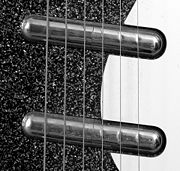
- Rickenbacker pickups (including the original 1930s "horseshoe" pickup as used in lap steel and solidbody upright basses, and later 6 string electric guitars, pedal steels, and electric bass guitars; also the "Toaster" and "Hi-Gain")
- Gibson bar pickup (1935) — later called the Charlie Christian pickupCharlie Christian pickupThe "Charlie Christian" pickup was an early electric guitar pickup. It was first used on the Gibson ES-150, which entered the market in 1936. The ES-150 was the first electric "Spanish-style" guitar; previous electric guitars had been designed to be played lap, or "Hawaiian" style...
(1938) - Gibson P-90P-90The P-90 is a single coil electric guitar pickup produced by Gibson since 1946. Having a more complex architecture and larger dimensions than Fender's single coils, it is occasionally mistaken for a humbucker.- History :...
(1946) - Fender Telecaster, Stratocaster, Jazzmaster, Jaguar, and other pickups
- Danelectro Lipstick
- Gretsch pickups (including the "HiLoTron")
- DeArmond pickups (found on various 50s and 60s guitars by various manufacturers including Gretsch, Guild, Epiphone, Martin, Kustom, Harmony, Regal, Premier, and others, but produced by the Rowe - DeArmond company of Toledo, Ohio; the trade name is now owned by Fender; single coil models including the 200 aka Dynasonic, 2K, and 2000, "mustache", various "gold foil" types, and many clip on, rail, or screw mount pickups designed for acoustic guitars and other instruments). The Fender "Tele-Sonic" featured large DeArmond single coils.
- Valco single coil pickups by Ralph Keller (1954) can be found in Airline, Supro, National, English Electronics, and a few Gretsch models of guitar from the 50's, 60's, and 70's. The majority of these pickups maintain the physical appearance of a larger, double coil humbucker pickup. Although consisting of a single coil, the pickup contains a second, off-set magnet which cancels hum. Early variations on the Valco made over-strings "horseshoe" pickup can be found on a number of similarly branded lapsteel guitars, such as Oahu.
- Epiphone "New York" pickups
- Lace SensorLace SensorThe Lace Sensor is a guitar pickup designed by Don Lace and manufactured by AGI since 1985.This line of electric guitar pickups was used exclusively by Fender from 1987 to 1996....
pickups (1987)

